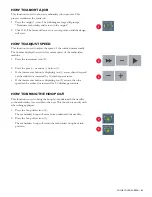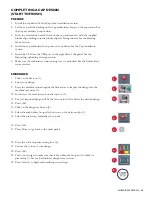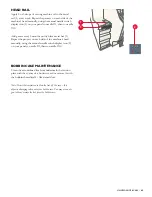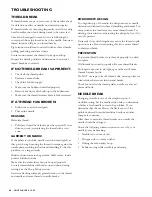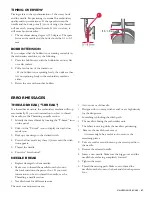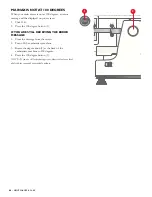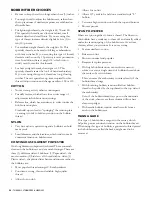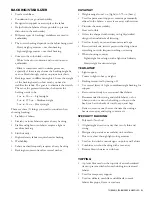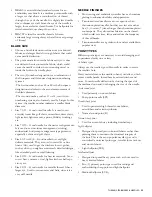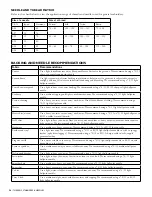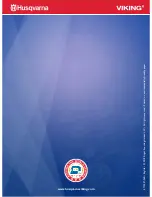
50
– THREADS, STABILIZERS & NEEDLES
BOBBIN FIBER CHOICES
• Be sure to keep the tails no longer than three (3) inches.
• You might need to adjust the bobbin case, rather than
the top tensioner if similar symptoms are exhibited on
all needle bars.
• For lightweight threads, the weight is 60, 70 and 80.
This specialty thread is used for fine fabrics, small
delicate details and small fonts. If you are using this
type of thread, increase density slightly by five (5) to
ten (10) percent.
• For medium-weight threads, the weight is 30. This
specialty thread can be used to fill large embroideries
with fewer stitches. If you are using this type of thread,
decrease stitch count by 15 percent; it saves production
time. In addition, there is weight 35, which is most
widely used for multi-color threads.
• For heavyweight threads, the weight is 12. This
specialty thread creates the look of hand embroidery.
If you are using this type of thread use long, floating
stitches. There is special set-up time required for this
thread. Adjust tension and change needle to 100 or 110.
COTTON
• Not as strong as its synthetic counterparts
• Friendly texture, which allows for a wider range of
adjustments in bobbin tension settings
• Releases lint, which has a tendency to collect under the
bobbin tension plate
Lint build-up can lead to “springing” the tension plate
– causing it to fail to hold any tension on the bobbin
thread
NYLON
• Very fine nylon is quite strong and a bobbin can hold
many yards
• Small diameter and slick texture, which tends to make
consistent tension on bobbin cases
CONTINUOUS FILAMENT POLYESTER
One long filament comprises the thread. These run much
cleaner in the bobbin case and are much stronger. There are
three (3) different sides of bobbins: (1) Paper sided – the
most common; (2) Sideless – all thread with no sides; (3)
Plastic sided – the plastic slides better and runs smoother in
the bobbin case.
• Most popular thread amongst U.S. embroiderers
• Consistent, strong, thin, and reliable, high-quality
thread
• Allows for no slub
• Allows for no lint
• Allows 127 yards to be held on a standard style “L”
bobbin
• Can run a higher tension on both the top and bottom
• More expensive
SPUN POLYESTER
Fibers are spun together to form a thread. The fibers on
this bobbin have a tendency to shear off and usually collect
under the tension spring of the bobbin case. Over time,
this may affect your tensions. It is not as strong.
• Texture similar to cotton
• Releases no lint
• Most economical and popular
• Requires less plate pressure
• With tight bobbin tension, can result in a narrow
column or even a single strand of bobbin thread down
the center of a satin column
This can cause the embroidery to unravel easily if the
bobbin thread snags
• With loosening bobbin, tension will allow bobbin
thread to be pulled by the top thread to the top side of
the embroidery.
Even if the bobbin thread stays put on the underside
of the work, chances are that columns will not have
clean crisp edges
• With erratic bobbin, tension usually results from a
catch in the bobbin case
MAGNA GLIDE
This type of bobbin has a magnet in the center, which
helps keep more consistent tension on the bobbin thread.
When using this type of bobbin, a gunmetal colored pieced
in the bobbin case, called the brake, might need to be
removed.






